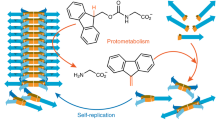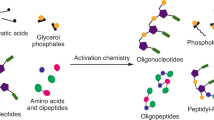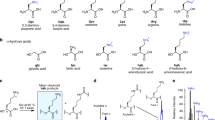Abstract
Self-replication has been demonstrated in synthetic chemical systems based on oligonucleotides1,2,3,4,5,6,7, peptides8,9,10,11,12 and complementary molecules without natural analogues13,14,15,16. However, within a living cell virtually no molecule catalyses its own formation, and the search for chemical systems in which both auto- and cross-catalysis can occur has therefore attracted wide interest17. One such system, consisting of two self-replicating peptides that catalyse each other's production, has been reported10. Here we describe a four-component peptide system that is capable of auto- and cross-catalysis and allows for the selective amplification of one or more of the products by changing the reaction conditions. The ability of this system selectively to amplify one or more molecules in response to changes in environmental conditions such as pH or salt concentration supports the suggestion8 that self-replicating peptides may have played a role in the origin of life.
This is a preview of subscription content, access via your institution
Access options
Subscribe to this journal
Receive 51 print issues and online access
$199.00 per year
only $3.90 per issue
Buy this article
- Purchase on Springer Link
- Instant access to full article PDF
Prices may be subject to local taxes which are calculated during checkout


Similar content being viewed by others
References
von Kiedrowski, G. Aself-replicating hexadeoxynucleotide. Angew. Chem. Int. Edn Engl. 25, 932–935 (1986).
von Kiedrowski, G., Wlotzka, B. & Helbing, J. Sequence dependence of template-directed syntheses of hexadeoxynucleotide derivatives with 3′-5′ pyrosphosphate linkage. Angew. Chem. Int. Edn Engl. 28, 1235–1237 (1989).
von Kiedrowski, G., Wlotzka, B., Helbing, J., Matzen, M. & Jordan, S. Parabolic growth of a self-replicating hexadeoxynucleotide bearing a 3′-5′ phosphoamidate linkage. Angew. Chem. Int. Edn Engl. 30, 423–426 (1991).
Sievers, D. & von Kiedrowski, G. Self-replication of complementary nucleotide-based oligomers. Nature 369, 221–224 (1994).
Achilles, T. & von Kiedrowski, G. Aself-replicating system from three starting materials. Angew. Chem. Int. Edn Engl. 32, 1198–1201 (1993).
Zielinski, W. S. & Orgel, L. E. Autocatalytic synthesis of a tetranucleotide analogue. Nature 327, 346–347 (1987).
Li, T. & Nicolaou, K. C. Chemical self-replication of palindromic duplex DNA. Nature 369, 218–221 (1994).
Lee, D. H., Granja, J. R., Martinez, J. A., Severin, K. & Ghadiri, M. R. Aself-replicating peptide. Nature 382, 525–528 (1996).
Severin, K., Lee, D. H., Kennan, A. J. & Ghadiri, M. R. Asynthetic peptide ligase. Nature 389, 706–709 (1997).
Lee, D. H., Granja, J. A., Severin, K., Yokobayashi, Y. & Ghadiri, M. R. Emergence of symbiosis in peptide self-replication through a hypercyclic network. Nature 390, 591–594 (1997).
Yao, S., Ghosh, I., Zutshi, R. & Chmielewski, J. ApH-modulated, self-replicating peptide. J. Am. Chem. Soc. 119, 10559–10560 (1997).
Yao, S., Ghosh, I., Zutshi, R. & Chmielewski, J. Aself-replicating peptide under ionic control. Angew. Chem. Int. Edn Engl. 37, 478–481 (1998).
Tjivikua, T., Ballester, P. & Rebek, J. J Aself-replicating system. J. Am. Chem. Soc. 112, 1249–1250 (1990).
Nowick, J. S., Feng, Q., Tjivikua, T., Ballester, P. & Rebek, J. J Kinetic studies and modeling of a self-replicating system. J. Am. Chem. Soc. 113, 8831–8839 (1991).
Wintner, E. A., Conn, M. M. & Rebek, J. J Self-replicating molecules: a second generation. J. Am. Chem. Soc. 116, 8877–8884 (1994).
Wintner, E. A., Tsao, B. & Rebek, J. J Evidence against an alternative mechanism for a self-replicating system. J. Org. Chem. 60, 7997–8001 (1995).
Orgel, L. E. Unnatural selection in chemical systems. Acc. Chem. Res. 28, 109–118 (1995).
Zhou, N. E., Kay, C. M. & Hodges, R. S. The role of interhelical ionic interactions in controlling protein folding and stability. De novo designed synthetic two-stranded alpha-helical coiled-coils. J. Mol. Biol. 237, 500–512 (1994).
Dawson, P. E., Muir, T. W., Clark-Lewis, I. & Kent, S. B. Synthesis of proteins by native chemical ligation. Science 266, 776–779 (1994).
Kramer, F. R., Mills, D. R., Cole, P. E., Nishihana, T. & Spiegelman, S. Evolution in vitro: sequence and phenotype of a mutant RNA resistant to ethidium bromide. J. Mol. Biol. 89, 719–736 (1974).
Acknowledgements
This work was supported by the NSF.
Author information
Authors and Affiliations
Corresponding author
Supplementary Information
Rights and permissions
About this article
Cite this article
Yao, S., Ghosh, I., Zutshi, R. et al. Selective amplification by auto- and cross-catalysis in a replicating peptide system. Nature 396, 447–450 (1998). https://doi.org/10.1038/24814
Received:
Accepted:
Issue Date:
DOI: https://doi.org/10.1038/24814
This article is cited by
-
Glycine to Oligoglycine via Sequential Trimetaphosphate Activation Steps in Drying Environments
Origins of Life and Evolution of Biospheres (2022)
-
Toward Molecular Cooperation by De Novo Peptides
Origins of Life and Evolution of Biospheres (2021)
-
Selection from a pool of self-assembling lipid replicators
Nature Communications (2020)
-
From self-replication to replicator systems en route to de novo life
Nature Reviews Chemistry (2020)
-
From Molecules to Life: Quantifying the Complexity of Chemical and Biological Systems in the Universe
Journal of Molecular Evolution (2018)
Comments
By submitting a comment you agree to abide by our Terms and Community Guidelines. If you find something abusive or that does not comply with our terms or guidelines please flag it as inappropriate.



